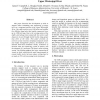Free Online Productivity Tools
i2Speak
i2Symbol
i2OCR
iTex2Img
iWeb2Print
iWeb2Shot
i2Type
iPdf2Split
iPdf2Merge
i2Bopomofo
i2Arabic
i2Style
i2Image
i2PDF
iLatex2Rtf
Sci2ools
HICSS
2007
IEEE
2007
IEEE
Decision Tools for Reducing Congestion at Locks on the Upper Mississippi River
This paper describes the development of tools to support better scheduling and sequencing of barge tows on a congested portion of the Upper Mississippi River. Our study section covers 100 miles and includes five 600-foot long locks that handle commercial tows up to 1200 feet long. Due to the varying nature of the traffic and lockage times (especially the need to split long tows to pass through smaller locks), long queues may form at the locks. This paper provides an overview of our research, including evaluation of lock and traffic management policies, development of a detailed multi-lock simulation model, evaluation of decision rules for sequencing vessels in queues, and development of a prototype GIS-based vessel tracking system. Our findings suggest that better sequencing of vessels at locks would provide small improvements at current traffic levels, but may reduce waiting time by as much as 25% with increasing levels of demand.
600-foot Long Locks | Biometrics | HICSS 2007 | Sequencing | System Sciences | Tows |
| Added | 02 Jun 2010 |
| Updated | 02 Jun 2010 |
| Type | Conference |
| Year | 2007 |
| Where | HICSS |
| Authors | James F. Campbell, L. Douglas Smith, Donald C. Sweeney II, Ray Mundy, Robert M. Nauss |
Comments (0)

